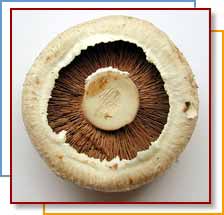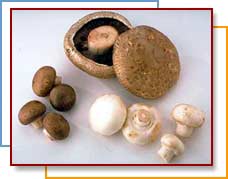
Mushrooms are not a true vegetable in the sense that it does not have
any leaves, roots, or seeds, and really does not need any light to grow.
So what exactly is a mushroom? It is a fungus, which grows in the dark and
creates more mushrooms by releasing spores. Mushrooms are found all over
the world and have been a very honored food in many cultures. Ancient
Egyptians considered mushrooms to be food for the royals. The French
adored the fungus and began harvesting them in caves during the
seventeenth century. These famous fungi didn't reach popularity in the
United States until the late 1800s.
Since mushrooms are grown from microscopic spores, Mushroom farming is
a step-by-step process that involves:
- two phases of composting
- spawning (mushroom farmer's collecting the spores)
- casing (a soil mixture that acts as a water reservoir that is placed
on top of the mushroom spores)
- pinning (the growth stage where the shape of the mushroom forms)
- harvesting
|
It's best to buy your mushrooms from a reputable grower or grocer
instead of hunting them yourself, as there are many poisonous
mushrooms. Incorrectly identifying them can lead to symptoms of
sweating, cramps, diarrhea, confusion, convulsions, and potentially
result in liver damage, or even death.
|
There are over 38,000 mushroom varieties today. Some are edible and
some are highly toxic. Here's a small sample of the most popular edible
mushrooms you'll see in the market:
 |
Agaricus (White or
Button)
These mushrooms are the most common variety prepackaged in
supermarkets; available fresh, canned, or frozen.
White mushrooms are mildly flavored, are tasty when eaten raw but
even more flavorful when cooked.
|
 |
Chanterelles, or Girolle
These trumpet shaped fungi are highly regarded mushrooms favored for
their gold to yellow color, and rich flavor, ranging from apricot to
earthier tasting. Chanterelles are best eaten fresh, although they
are also available dried or canned.
|
 |
Crimini, or Italian Brown
These mushrooms are similar to the button variety, yet they are
darker in color, have a richer flavor, and have a more dense
texture. Criminis were once an imported mushroom but are now grown
domestically.
|
 |
Enoki, or Enokitake
This fungi takes on a sproutlike appearance with small caps and
thin, long, stems. Native to Japan, white in color, with a light
fruity taste, these mushrooms are excellent when served raw in soups
and salads.
|
 |
Morel
These mushrooms are highly priced and highly prized for their
intense earthly flavor. They are usually found in the wild, although
can now be grown commercially. This conical shaped, honey combed
surface fungi is small, with dark brown hues, is suitable for
stuffing and is ideal for sauces and stews.
|
 |
Oyster, or Pleurotus
These mushrooms grow in clusters, and range in color from off-white
to shades of brown. Subtly tasting like an oyster, its chewy texture
is more suited to cooked dishes.
|
 |
Porcino
Porcini mushrooms are well valued for their meaty texture,
interesting flavor, and distinguishing shape. These mushrooms vary
in size and is domestically grown or imported from Europe depending
on the season. This variety is usually expensive, but is considered
one of the finest-tasting mushrooms.
|
 |
Portobello
These are large cremini-like mushrooms that are sometimes the size
of a regular hamburger! These fungi are circular, flat, and long,
with a dense, chewy texture. Portobellos are excellent for grilling
or roasting.
|
 |
Shiitake
Shiitake mushrooms were originally cultivated on natural oak
logs and only grown in Japan, but are now available domestically.
These mushrooms are large, black-brown, and have an earthy rich
flavor. This fungi is enjoyed in stir-fries, soups, or even a meat
substitute. Dried Shiitakes have more intense flavors and are
sometimes preferable to fresh.
|
Clean mushrooms only when you are ready to use them. Remove any bits of
the debris on the surface, rinse with cold running water or gently wipe
the mushrooms with a damp cloth, paper towel, or soft brush.
|
How do I use dried mushrooms? Dried mushrooms are intensely
concentrated in flavor and should be treated more like a seasoning
than a vegetable. You'll need to soak the dried mushrooms in hot
water for 20-30 minutes, rinse, then chop, and use. Saving the
soaking water and adding it to your sauces or soups will intensify
the mushroom flavor.
|
Mushrooms are available all year long and although there are many
different varieties, selecting any kind of mushrooms are easy. You should
look for firm, moisture-free (not dry), unblemished caps, and free of
mold. Place purchased loose mushrooms in a paper bag in the refrigerator.
Airtight plastic bags tend to retain moisture and will accelerate
spoilage. Properly stored mushrooms will last for approximate five days.
Mushrooms can be frozen but they must be cleaned, cooked, and placed in
a ½ cup or 1 cup container to freeze. Don't forget to mark the date on
the container, frozen mushrooms will last several months.
Mushrooms are versatile and may be eaten raw or cooked whole, sliced or
chopped. Certain varieties like shiitake and portabella, must have their
stems discarded or used as a flavoring agent, as they are often tough.
Preparation Hint: Squeeze a small amount of lemon juice on the mushrooms
to retain the color.
|
|
Cooked Mushrooms |
Serving
size 1/2 cup (78g)
|
Amounts
Per Serving |
% Daily
Value |
| Calories 20 |
|
| Calories
from Fat 5 |
|
| Total Fat 0g |
0% |
| Saturated
Fat 0g |
0% |
| Sodium 0mg |
0% |
| Cholesterol
0mg |
0% |
| Total
Carbohydrate 4g |
1% |
|
Dietary Fiber 2g |
7% |
|
Sugars 2g |
|
| Protein 2g |
|
| Vitamin A |
0% |
| Vitamin C |
6% |
| Calcium |
0% |
| Iron |
8% |
* Percent Daily Values are based on a
2,000 calorie diet.
|
|
| |
|
|
|
| Raw Mushrooms |
Serving
size 1/2 cup (35g)
|
Amounts
Per Serving |
% Daily
Value |
| Calories
10 |
|
| Calories
from Fat 0 |
|
| Total Fat 0g |
0% |
| Saturated
Fat 0g |
0% |
| Sodium 0mg |
0% |
| Cholesterol
0mg |
0% |
| Total
Carbohydrate 1g |
0% |
|
Dietary Fiber 0g |
0% |
|
Sugars 1g |
|
| Protein 1g |
|
| Vitamin A |
0% |
| Vitamin C |
2% |
| Calcium |
0% |
| Iron |
2% |
* Percent Daily Values are based on a
2,000 calorie diet.
|
|
| |
|
|
Recipes

Fresh Mushroom Soup
Serves 4 (1 ½ cup servings)
Each serving equals 1/2 cup of fruit or vegetables
Source: Produce for Better Health/M.J. Smith
Ingredients
1½ pounds fresh mushrooms
8 scallions
½ tsp thyme
¼ tsp black pepper
1 Tbsp Dijon mustard
½ cup red wine
1 quart fat-free no-added-salt chicken broth
1 cup plain non-fat yogurt
Chop mushrooms and scallions into bite-sized pieces. Place in non-stick
Dutch oven and cook with red wine until tender. Add thyme, pepper,
mustard, and chicken broth. Bring to a boil and simmer for 15 minutes. Add
yogurt, stirring just to blend, and serve. Makes 4 (1½ cup) servings.
Nutritional analysis per serving: Calories 135, Fat 2g, Calories from
Fat 13%, Protein 15g, Cholesterol 1mg, Fiber 3g, Sodium 164mg.

Find more in our
recipe database!
|



